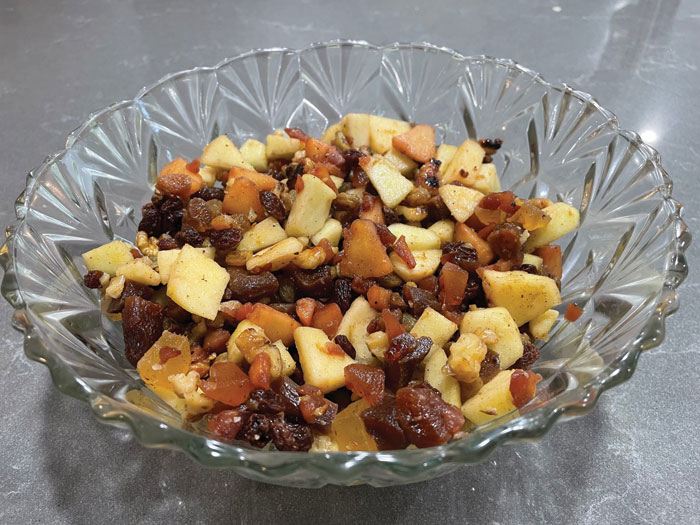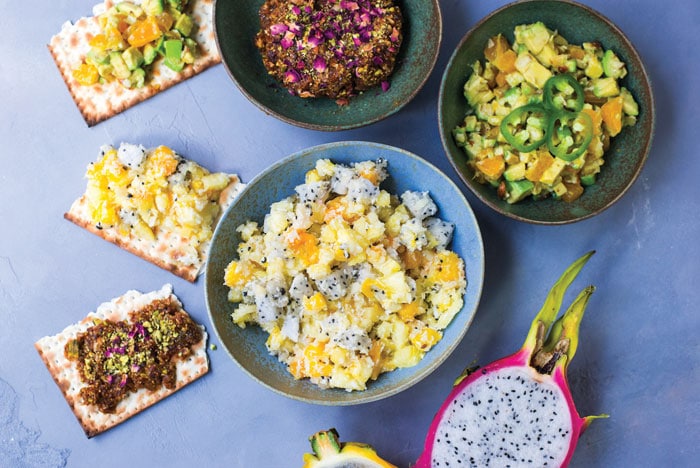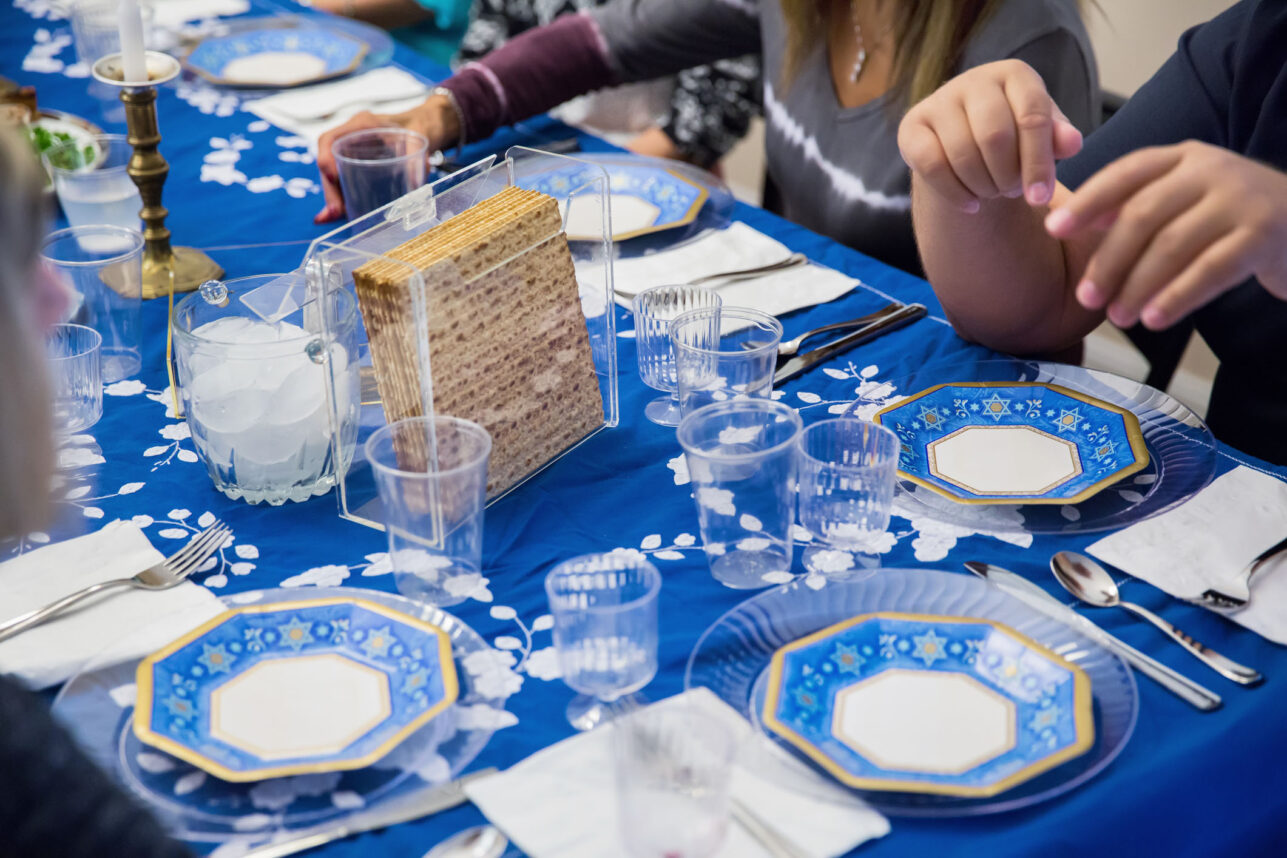 Jeff Frymer’s Charoset
(Photo courtesy of Jeff Frymer)
Jeff Frymer’s Charoset
(Photo courtesy of Jeff Frymer) Charoset is one of the stars of the Passover Seder. A sweet, paste-like mixture of fruits and nuts, representing mortar, charoset is combined with maror (bitter herbs) between two matzot to make a Hillel sandwich during the Seder. This significant side can be enjoyed on matzah throughout the meal … and throughout Passover. There are plenty of variations on charoset, as well as ideas on how to create it.
This leads to the lesser-known fifth question: “How do you make the perfect charoset?”
“Let me just start by saying I don’t really like charoset; I love it!” Chef Jeff Frymer told the Journal. “It’s not only about the taste, though taste is crucial to be sure. It’s the culinary playground the dish presents.”
He specializes in working with neurodiverse individuals and families and is married to Elaine Hall, founder and artistic director of The Miracle Project, a non-profit, inclusive theater and film program.
Frymer’s love of cooking began at an early age when he watched Graham Kerr and Julia Child. He learned to flip crepes with his mom at the age of nine, and prepare chopped liver and gefilte fish with his grandmother.
“Every year on Passover I am made keenly aware that I am the first born,” Frymer said. “So of course, if G-d went out of his way to spare me, I’d better put some effort into this life I’ve been given. Like every Jewish holiday, that effort always involves food. And in my family, not just food, but great food.”
Since Frymer’s taste tends to be on the savory side, when a friend asked him to make the charoset for a pre-pandemic Seder, he took the challenge. He starts with many of the typical charoset ingredients, but makes adjustments to his taste. And he prefers to use organic and farmer’s market ingredients.
“Cooking, for me, is informed by the ingredients, and the alchemy is informed by my senses – not only the way things taste and smell, but also texture and aesthetic,” he said. “The dish should first draw diners in through their olfactory senses, entice them by its visual appeal and then delightfully land on their palate in a complex burst of flavor.“
Chef Jeff’s Charoset
1. In a bowl, mix together two green and two fuji apples (chop 1/3 of apples fine and 2/3 into larger chunks); walnuts (pan roasted till fragrant, as one would do pine nuts, and then crumbled a bit by hand); one cup raisins (medley of varieties for taste, texture, and presentation); one cup dried apricots (sulphur free) and 1/2 cup candied ginger. Drizzle juice from one lemon with teaspoon-ish of honey over apple and fruit mix (to preserve the color) and set aside.
3. Once you have it tasting where you want it, add half the fruit and nut mixture and to the liquid and simmer, stirring occasionally, for about 10 to 15 minutes. Pour out into a strainer and reserve the liquid. Once cool, toss everything together and make adjustments to taste if necessary with reserved reduction, lemon juice, cinnamon, honey and salt.
“I tend to make more than I think is enough as always, but somehow there never seems to be leftovers.” – Jeff Frymer
“I tend to make more than I think is enough as always, but somehow there never seems to be leftovers,” Frymer said.
***
Samantha Ferraro, author of “The Weeknight Mediterranean Kitchen” and founder of The Little Ferraro Kitchen, grew up with Passover Seders influenced by both her mother’s Sephardic and father’s Ashkenazi roots.
“Even though the holidays were celebrated similarly, the foods that we ate were different,” she said. “On my father’s side, we would have an elaborate Seder full of matzah ball soup [and]read the four questions, and my cousins and I [would] scurry around the house to try and find the afikoman. On my mom’s [Sephardic] side, we would happily enjoy fried matzah donuts called Bimeulos that we would dip in simple syrup.”
Ferraro said there’s nothing like her mother’s classic charoset that she grew up on. “She kept it chunky with chopped apples, walnuts, tart cranberries and a good splash of red wine, just to bring everything together,” Ferraro told the Journal. “I have very fond memories of scooping up the red-stained charoset on matzah crackers and eating it very happily – though, that could have also been the wine talking.”
For charoset variations, Ferraro takes inspiration from the places she has lived and the cultures she admires. For instance, her tropical charoset, which has chopped pineapple, mango, macadamia nuts and shredded coconut, was inspired from growing up in Hawaii.
“The beautiful thing about Jewish cuisine is that it is ever-evolving and molding to the environment and people in it,” Ferarro said. “So whatever charoset you choose to make, have fun with the flavors and textures, different nuts or seasonal produce.”

Passover Charoset Three Ways from The Little Ferraro Kitchen
Tropical Charoset
1 cup diced pineapple
1 cup cubed dragon fruit or sub papaya
¾ cup cubed mango
¼ cup ground macadamia nuts
¼ cup shredded coconut
Add all ingredients to a bowl and stir to combine.
Persian Charoset
3 dried figs
3 pitted dates
6 dried apricots
2 tablespoons golden raisins
1 teaspoon pomegranate molasses
2 tablespoons roughly chopped
pistachios + more for garnish
2 tablespoons roughly chopped almonds
½ teaspoon cinnamon
¼ teaspoon cardamom
2 tablespoons fruit juice just in case
mixture is too dry
Dried rose petals for garnish (optional)
Add all ingredients to a food processor and blend until evenly incorporated. If you don’t have a food processor, you can chop all the ingredients finely and stir to combine.
Tex-Mex Charoset
1 avocado pitted and cubed
1 orange peeled and chopped into
small cubes
Juice of 1 lime
2 tablespoons ground almonds or
ground pepitas
½ jalapeno seeded and finely diced
(optional for heat)
½ teaspoon tajin spice or substitute
lime zest + ½ tsp. chili powder
Salt to taste
Combine all ingredients in a bowl and stir to combine.
Notes: The Persian charoset uses dried fruit and can be made into truffle balls as well. The other fresh charoset are best served within two days, or the texture changes a bit























 More news and opinions than at a Shabbat dinner, right in your inbox.
More news and opinions than at a Shabbat dinner, right in your inbox.